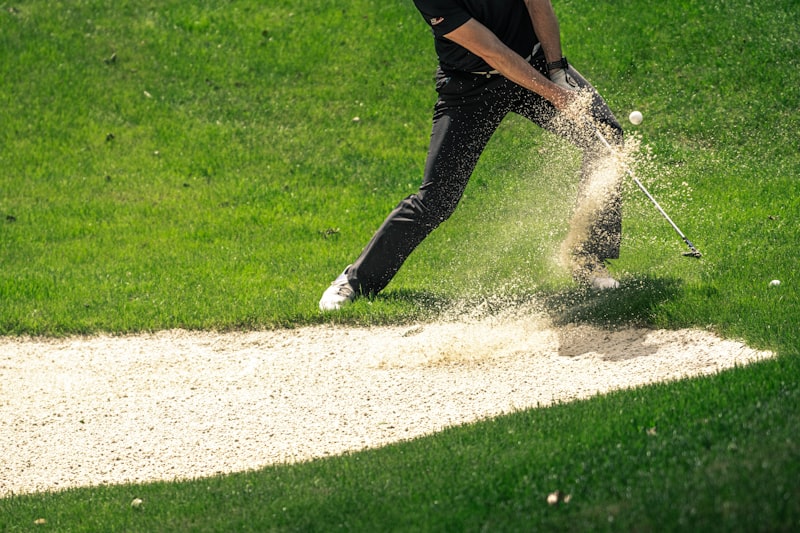Content Summary
What is a Sand Wedge?
Golfers are often confused about just what a wedge is. Because there are a few different types, a quick explanation will be helpful. Wedges are used because they provide a good amount of back spin to stop shots quickly on the green.
A sand wedge is a type of golf club that is used for a variety of shots, including bunker shots, muddy lies and short approach shots to the green.
It has a wide, rounded sole that helps to prevent the club from digging into the sand or mud, and a high loft angle that creates a lot of backspin on the ball. What loft is a sand wedge? The sand wedge loft usually ranges from 54-58 degrees.
Another club with a high amount of loft is the lob wedge. What loft is a lob wedge? This club usually comes with 60 degrees of loft and is a specialty club for use around the green to produce high short shots over obstacles where the pin is close to the edge of the green and you need to land the shot close to the pin and have it stop quickly.
The next wedge is the gap wedge this club usually has 52 wedge degrees. This club helps with shots between 90-100 yards to the green.
Finally we have the pitching wedge with a pitching wedge loft of 41-46 degrees. For some, this is the best wedge due to its flexibility from 120 yards in.
You can hit full shots, chip shots, low running shots and even use it out of bunkers. This club is more like the higher numbered clubs in your bag and not so much like the specialty clubs above with their high golf wedge degrees.
Bounce
Bounce, another confusing term for golfers. All irons are designed with a sole that is perpendicular to the shaft of the club. This puts their sole just parallel to the ground when a ball is being addressed by the player. The angle lets the leading edge of the clubhead get between the ball and the ground when making impact. On the other hand, the sand wedge is designed so the sole is at an angle to the ground when placed in the same way as the iron.
This angled sole is designed to help lift the leading edge up off the ground at the bottom of your swing, which keeps the clubhead from digging into soft lies such as sand, mud, and heavy grass.
How the Sand Wedge is Used in Golf
Golf is a sport that many people enjoy. It is a game of skill and strategy, and can be quite challenging. One important element of the game is the club you use.
Each club has a different purpose, and choosing the right one can make a big difference in your game. The sand wedge is an important club to have in your bag, and knowing how to use it can give you an advantage on the course.
The sand wedge is used for shots that are close to the green, but not quite close enough to use a putter. It can also be used for approach shots, or any shot where you need to get over a hazard or bunker or out of a bunker.
The sand wedge has a higher loft than other clubs, which means it will travel higher and land softer. This makes it perfect for shots where you need to stop the ball quickly, without it rolling too far.
Why use a sand wedge? The main reason to use a sand wedge is because it is much more controlled than other club types. You can play shots that fly high in the air but still land on the green. So, If you find yourself in a bunker, don't panic!
Just take a deep breath and swing your sand wedge nice and easy. Remember to keep your weight forward and your hands close to the ground, and you'll be hitting great shots in no time!
The History of the Sand Wedge
The sand wedge was first invented in 1931 by American golfer Gene Sarazen. Sarazen's original design had a loft of 56 degrees and was made with a flanged blade. The sand wedge quickly gained popularity among professional golfers and soon became standard equipment for many amateurs as well.
The sand wedge has undergone numerous changes over the years, with different manufacturers experimenting with different designs and materials.
Today, there are many different types of sand wedges available on the market, with each offering its own unique benefits. Whether you're a beginner or a seasoned pro, there's sure to be a sand wedge that's perfect for your game.
How to Choose the Right Sand Wedge
Almost every golfer has a trusty old sand wedge that they’ve been hitting the links with for years. But what many golfers don’t realize is that there is such a thing as having the wrong sand wedge. The degree of loft on your sand wedge is crucial to getting out of those pesky bunkers.
The average sand wedge has anywhere from 54 to 58 degrees of loft. If you find yourself consistently struggling to get out of the bunker, it might be time to invest in a new one with more loft.
Conversely, if you find that you are consistently blasting the ball too far past the hole, you might want to consider a sand wedge with less loft or lob wedge loft.
There are also different types of of custom wedge with sole grinds on sand wedges these days. The average sole grind is a 50 degree wedge that has a slight amount of bounce angle (the curvature at the bottom of the club head).
Some people prefer golf wedges with this type of sole, others find it easier to control with a flatter sole like a 60 degree wedge with no bounce.
Conclusion
Sand wedgee vs lob wedges vs gap wedges vs pitching wedges. You have many choices. How many wedges do you prefer? Personally I use a pitching and gap wedge along with the sand wedge. I leave the specialty wedge lofts to the single digit handicappers.






